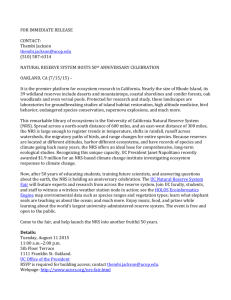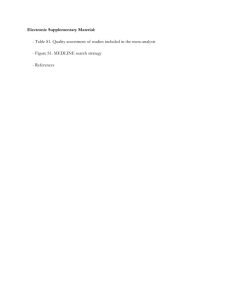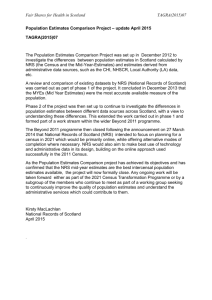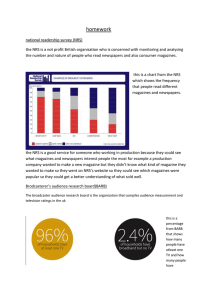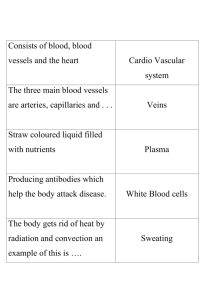Respiratory Assessment
advertisement
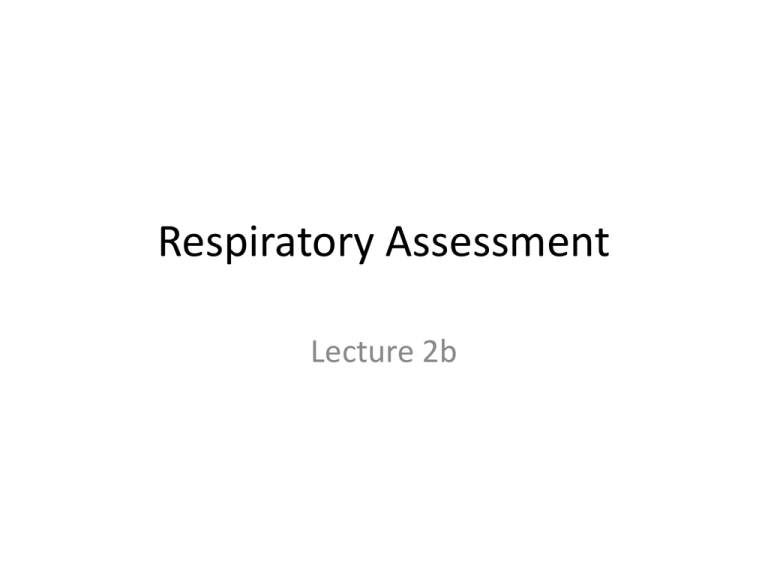
Respiratory Assessment Lecture 2b Assessment of breathing ability • • • • Pulmonary function test Pulse oximeter Radiographic exams Lab values Pulmonary Function Tests Purpose • Assess resp. function – – – – Tidal volume Vital capacity Rate Inspiratory force • Progress of disease Pulse Oximeter Purpose • Noninvasive O2 Sat Normal • 95-100% • <85% – Tissue is not receiving enough O2 Pulse oximeter Not reliable in… • Cardiac arrest • Shock • Vasoconstrictive meds • Dyes • Anemia • High CO levels The most appropriate nursing intervention for a client requiring a finger probe pulse oximeter is to: A. Apply the sensor probe over a finger and cover lightly with gauze to prevent skin breakdown B. Set alarms on the oximeter to at least 100% C. Identify if the client has had a recent diagnostic test using intravenous dye D. Remove the sensor between oxygen saturation readings Radiographic exams • • • • • • • • • Chesk x-ray CT scan PET Fluroscopy Barium Swallow Angiography Bronchoscopy Thoracoscopy Thoracentesis Chest x-ray Description • 2-d image Purpose • Fluid • Tumor • Foreign bodies Chest – X-ray Nrs management • Call pink ladies • Normal heart size & clear lung field CT Scan Description • Computerize Tomography • With or without contrast medium Purpose • Tissue • Tumor • Foreign bodies • Fluid CT scan Nrs management • Without contrast medium – No prep • With contrast medium – NPO 6 hrs – Assess for allergies Positron Emission Tomography PET Purpose • Confirm adequate blood supply Description • Radioactive tracers injected IV Fluoroscopy Purpose • Detect movement – Diaphragm paralysis Description • X-ray Barium Swallow Purpose • View esophagus and cardiac sphincters Description • Drink barium • X-ray Barium swallow Nrs Management • NPO • Post-procedure – Laxatives – BM white Angiography Purpose • Pulm. Circulation Description • Dye • Femoral vein • Heart • Pulm Arteries Angiography Nrs. Management • Pre-op – NPO – Check Allergies • Shellfish/iodine • Post-op – – – – – Lie flat 8 hrs Sandbag Check pedal pulses Assess hemorrhaging Push fluids • Normal pulmonary angiography Bronchoscopy Description • Direct inspection of larynx, trachea & bronchi via flexible tube (fiberoptic) Purpose • Examine • Tissue sample Bronchoscopy • Nrs Management • Pre-op – NPO 6-8 hrs – Sedation • i vegal response • i cough/gag reflex • i anxiety Bronchoscopy Nrs management • Post-op – – – – Side-ling until gag back NPO till gag back Check gag Check bleeding Thoracoscopy Description • Fiber-optic inspection of thoracic cavity • Incision Purpose • Inspect • tissue sample Thoracentesis Purpose • Remove fluid for dx • Remove fluid for tx • Obtain biopsy • Instill meds Thoracentesis Nrs Management • Position patient • Support • Post-op – – – – Vital signs q 15 Chest x-ray Breath sounds – bilateral Cover site • Check bleeding • Check drainage Lab Values • • • • • • Sputum WBC Hemoglobin Hematocrit ABG’s PTT/PT Sputum studies • Check for – Pathogens • C&S • Acid-fast bacillus – What? • TB – Duration • 4-6 wks White Blood Cell Count • Normal – 5,000 – 10,000 cell/mm3 • Elevated – Bacterial infection • Decreased – Leukemia – Viral infection Hemoglobin Normal • Female: 12-16 g/dl • Male:14-18 g/dl Elevated • COPD • Dehydration Decreased • Anemia • Hemorrhaging • Over hydration Hematocrit Normal • Female: 37-47% • Male: 42-52% Elevated • Dehydration • Burns • COPD Decreased • Anemia • Leukemia Arterial Blood Gases Purpose • Adjust O2 levels • Hypoxemia Description • Must by arterial blood Arterial Blood Gases Values • pH • PaO2 • PaCO2 • HCO3• SaO2 ABG’s pH • Normal – 7.35-7.45 • Elevate – > 7.45 – Alkalosis • Decreased – <7.35 – Acidosis pH Quiz: Acidosis or alkalosis • Arterial blood pH of 7.51? – Alkalosis • Arterial blood pH of 7.30? – Acidosis • Arterial blood pH of 7.34 – Acidosis • Arterial blood pH of 7.43 – Normal / homeostasis ABG’s • PaO2 • Normal – 80-100 torr • Elevated – Hypervenilation • Decreased – i resp. function – Hypoxemia ABG’s PaCO2 • Normal – 35-45 mmHg • Elevated – Hypercapnia – Impaired gas exchange • Decreased – Hyperventilation ABG’s HCO3• Normal – 22-26 SaO2 • Normal – 95-100% • Decreased – Hypoxemia PTT/PT Partial Thromboplastin Time • Prolonged – – – – Liver disease Vit K deficiency Anticoagulant Hemophilia Quiz? • A. B. C. D. The main function of platelets is to… Provide oxygen to tissue Fight viral infections Fight bacterial infections Form a blood clot A fragile 87 year-old female has recently been admitted to the hospital with increased confusion and falls over last 2 weeks. She is also noted to have a mild left hemiparesis. Which of the following tests is most likely to be performed? A. B. C. D. FBC (full blood count) ECG (electrocardiogram) Thyroid function tests CT scan • A 84 year-old male has been loosing mobility and gaining weight over the last 2 months. The patient also has the heater running in his house 24 hours a day, even on warm days. Which of the following tests is most likely to be performed? A. B. C. D. FBC (full blood count) ECG (electrocardiogram) Thyroid function tests CT scan • A 20 year-old female attending college is found unconscious in her dorm room. She has a fever and a noticeable rash. She has just been admitted to the hospital. Which of the following tests is most likely to be performed first? A. B. C. D. Blood sugar check CT scan Blood cultures Arterial blood gases • A 28 year old male has been found wandering around in a confused pattern. The male is sweaty and pale. Which of the following tests is most likely to be performed first? A. B. C. D. Blood sugar check CT scan Blood cultures Arterial blood gases • A nurse is administering blood to a patient who has a low hemoglobin count. The patient asks how long to RBC’s last in my body? The correct response is. A. The life span of RBC is 45 days. B. The life span of RBC is 60 days. C. The life span of RBC is 90 days. D. The life span of RBC is 120 days.



